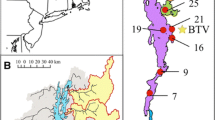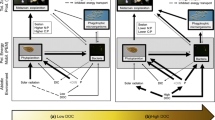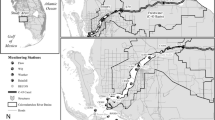Abstract
Losses of phosphorus (P) and nitrogen (N) have important influences on in-lake concentrations and nutrient loading to downstream ecosystems. We performed a series of mesocosm experiments along a latitudinal gradient from Sweden to Greece to investigate the factors influencing N and P loss under different climatic conditions. In six countries, a standardised mesocosm experiment with two water depths and two nutrient levels was conducted concurrently between May and November 2011. Our results showed external nutrient loading to be of key importance for N and P loss in all countries. Almost all dissolved inorganic nitrogen (DIN) and soluble reactive phosphorus (SRP) were lost or taken up in biomass in all mesocosms. We found no consistent effect of temperature on DIN and SRP loss but a significant, though weak, negative effect of temperature on total nitrogen (TN) and total phosphorus (TP) loss in the deeper mesocosms, probably related to higher organic N and P accumulation in the water in the warmer countries. In shallow mesocosms, a positive trend in TN and TP loss with increasing temperature was observed, most likely related to macrophyte growth.






Similar content being viewed by others
References
Brett, M. T. & M. M. Benjamin, 2008. A review and reassessment of lake phosphorus retention and the nutrient loading concept. Freshwater Biology 53: 194–211.
Bucak, T., E. Saraoğlu, E. E. Levi, Ü. N. Tavşanoğlu, A. I. Çakıroğlu, E. Jeppesen & M. Beklioğlu, 2012. The influence of water level on macrophyte growth and trophic interactions in eutrophic Mediterranean shallow lakes: a mesocosm experiment with and without fish. Freshwater Biology 57: 1613–1642.
Cook, P. L. M., K. T. Aldrige, S. Lamontage & J. D. Brookes, 2010. Retention of nitrogen, phosphorus and silicon in a large semi-arid riverine lake ecosystem. Biogeochemistry 99: 49–63.
Correl, D. L., 1998. The role of phosphorus in the eutrophication of receiving waters: a review. Journal of Environmental Quality 27: 261–266.
Danger, M., G. Lacroix, C. Oumarou, D. Benest & J. Mériguet, 2008. Effects of food-web structure on periphyton stoichiometry in eutrophic lakes: a mesocosm study. Freshwater Biology 53: 2089–2100.
Davidsson, T. E. & L. Leonardson, 1998. Seasonal dynamics of denitrification activity in two water meadows. Hydrobiologia 364: 189–198.
Desmet, N. J. S., S. Van Belleghem, P. Seuntjens, T. J. Bouma, K. Buis & P. Meire, 2011. Quantification of the impact of macrophytes on oxygen dynamics and nitrogen retention in a vegetated lowland river. Physics and Chemistry of the Earth 36: 479–489.
Duarte, C. M., 1992. Nutrient concentration of aquatic plants - patterns across species. Limnology and Oceanography 37: 882–889.
Feuchtmayr, H., R. Moran, K. Hatton, L. Connor, T. Heyes, B. Moss, I. Harvey & D. Atkinson, 2009. Global warming and eutrophication: effects on water chemistry and autotrophic communities in experimental hypertrophic shallow lake mesocosm. Journal of Applied Ecolology 46: 713–723.
Gomez, E., M. A. Fillit, M. C. Ximenes & B. Picot, 1998. Phosphate mobility at the sediment–water interface of a Mediterranean lagoon (etang du Mejean), seasonal phosphate variation. Hydrobiologia 374: 203–216.
González Sagrario, M. A., E. Jeppesen, J. Gomá, M. Søndergaard, J. P. Jensen, T. L. Lauridsen & F. Landkildehus, 2005. Does high nitrogen loading prevent clear-water conditions in shallow lakes at moderately high phosphorus concentrations? Freshwater Biology 50: 27–41.
Guildford, S. J. & R. E. Hecky, 2000. Total nitrogen, total phosphorus, and nutrient limitation in lakes and oceans: is there a common relationship? Limnology and Oceanography 45: 1213–1223.
Finlay, J. C., G. E. Small & R. W. Sterner, 2013. Human influences on nitrogen removal in lakes. Science 342: 247–250.
Fisher, J. & M. C. Acreman, 2004. Wetland nutrient removal: a review of the evidence. Hydrology and Earth System Sciences 8: 673–685.
Han, H., N. Bosch & J. D. Allan, 2011. Spatial and temporal variation in phosphorus budgets for 24 watersheds in the Lake Erie and Lake Michigan basins. Biogeochemistry 102: 45–58.
Hasler, A. D., 1947. Eutrophication of lakes by domestic drainage. Ecology 28: 383–395.
Herrman, K. S., V. Bouchard & R. H. Moore, 2008. Factors affecting denitrification in agricultural headwater streams in Northeast Ohio, USA. Hydrobiologia 598: 305–314.
Jensen, J. P., P. Kristensen & E. Jeppesen, 1990. Relationships between nitrogen loading and in-lake concentrations in shallow Danish lakes. Verhandlungen der Internationalen Vereinigung für Theoretische und Angewandte Limnologie 24: 201–204.
Jeppesen, E., M. Søndergaard, J. P. Jensen, K. E. Havens, O. Anneville, L. Carvalho, M. F. Coveney, R. Deneke, M. T. Dokulil, B. Foy, D. Gerdeaux, S. E. Hampton, S. Hilt, K. Kangur, J. Köhler, E. H. R. R. Lammens, T. L. Lauridsen, M. Manca, M. R. Miracle, B. Moss, P. Nõges, G. Persson, G. Phillips, R. Portielje, S. Romo, C. L. Schelske, D. Straile, I. Tatrai, E. Willen & M. Winder, 2005. Lake responses to reduced nutrient loading – an analysis of contemporary long-term data from 35 case-studies. Freshwater Biology 50: 1747–1771.
Jeppesen, E., M. Søndergaard, M. Meerhoff, T. L. Lauridsen & J. P. Jensen, 2007a. Shallow lake restoration by nutrient loading reduction − some recent findings and challenges ahead. Hydrobiologia 584: 239–252.
Jeppesen, E., M. Søndergaard, A. R. Pedersen, K. Jurgens, A. Strzelczak, T. L. Lauridsen & L. S. Johansson, 2007b. Salinity induced regime shift in shallow brackish lagoons. Ecosystems 10: 47–57.
Jeppesen, E., B. Moss, H. Bennion, L. Carvalho, L. De Meester, H. Feuchtmayr, N. Friberg, M. O. Gessner, M. Hefting, T. L. Lauridsen, L. Liboriussen, H. Malmquist, L. May, M. Meerhoff, J. O. Olafson, M. Soons, J. T. A. Verhoeven, M. Kernan & R. W. Battarbee, 2010. Interaction of climate change and eutrophication. In Kernan, M., R. W. Battarbee & B. Moss (eds), Climate Change Impacts on Freshwater Ecosystems. Wiley, Chichester: 119–215.
Jeppesen, E., B. Kronvang, J. E. Olesen, J. Audet, M. Søndergaard, C. C. Hoffmann, H. E. Andersen, T. L. Lauridsen, L. Liboriussen, S. E. Larsen, M. Beklioglu, M. Meerhoff, A. Özen & K. Özkan, 2011. Climate change effects on nitrogen loading from cultivated catchments in Europe: implications for nitrogen retention, ecological state of lakes and adaptation. Hydrobiologia 663: 1–21.
Kankaala, P., A. Ojala, T. Tulonen & L. Arvola, 2002. Changes in nutrient retention capacity of boreal aquatic ecosystems under climatic warming: a simulation study. Hydrobiologia 469: 67–76.
Kaste, O. & P. J. Dillon, 2003. Inorganic nitrogen retention in acid-sensitive lakes in southern Norway and southern Ontario, Canada—a comparison of mass balance data with an empirical N retention model. Hydrological Processes 17: 2393–2407.
Koçak, M., N. Kubilay, S. Tuğrul & N. Mihalopoulos, 2010. Atmospheric nutrient inputs to the northern Levantine basin from a long-term observation: sources and comparison with riverine inputs. Biogeosciences 7: 4037–4050.
Kosten, S., V. M. L. Huszar, N. Mazzeo, M. Scheffer, L. D. S. L. Sternberg & E. Jeppesen, 2009. Lake and watershed characteristics rather than climate influence nutrient limitation. Ecological Applications 19: 1791–1804.
Landkildehus, F., M. Søndergaard, M. Beklioglu, R. Adrian, D. G. Angeler, J. Hejzlar, E. Papastergiadou, P. Zingel, A. I. Çakiroğlu, U. Scharfenberger, S. Drakare, T. Nõges, M. Šorf, K. Stefanidis, N. Tavşanoğlu, C. Trigal, A. Mahdy, C. Papadaki, L. Tuvikene, S. E. Larsen, M. Kernan & E. Jeppesen, 2014. Climate change effects on shallow lakes: design and preliminary results of a cross-European climate gradient mesocosm experiment. Estonian Journal of Ecology 63: 71–89.
Lewis, W. M. & W. A. Wurtsbaugh, 2008. Control of lacustrine phytoplankton by nutrients: erosion of the phosphorus paradigm. International Review of Hydrobiology 93: 446–465.
Likens, G., 1972. Nutrients and Eutrophication, American Society of Limnology Oceanography Special Symposium 1. American Society of Limnology Oceanography, Lawrence.
Madsen, J. D., P. A. Chambers, W. F. James, E. W. Koch & D. F. Westlake, 2001. The interaction between water movement, sediment dynamics and submersed macrophytes. Hydrobiologia 444: 71–84.
Messer, J. J. & P. L. Brezonik, 1978. Denitrification in the sediments of Lake Okeechobee, Florida. Verhandlungen der Internationale Vereinigung der Limnologie 20: 2207–2216.
Moss, B., S. Kosten, M. Meerhoff, R. W. Battarbee, E. Jeppesen, N. Mazzeo, K. Havens, G. Lacerot, Z. Liu, L. De Meester, H. Paerl & M. Scheffer, 2011. Allied attack: climate change and eutrophication. Inland Waters 1: 101–105.
Moss, B., E. Jeppesen, M. Søndergaard, T. L. Lauridsen & Z. Liu, 2013. Nitrogen, macrophytes, shallow lakes and nutrient limitation: resolution of a current controversy? Hydrobiologia 710: 3–21.
Nõges, P., 2005. Water and nutrient mass balance of the partly meromictic temperate Lake Verevi. Hydrobiologia 547: 21–31.
Nõges, P., J. Arvo, L. Tuvikene & T. Nõges, 1998. The budgets of nitrogen and phosphorus in shallow eutrophic Lake Vortsjärv (Estonia). Hydrobiologia 363: 219–227.
Olsen, S., E. Jeppesen, B. Moss, K. Özkan, M. Beklioğlu, H. Feuchtmayr, M. González-Sagrario, L. Wei, S. Larsen & M. Søndergaard, 2015. Effect of nitrogen and phosphorus loading, salinity, temperature and water level on the nitrogen retention capacity in lakes: an experimental approach. Freshwater Biology 60: 646–662.
Özen, A., B. Karapinar, I. Kucuk, E. Jeppesen & M. Beklioglu, 2010. Drought-induced changes in nutrient concentrations and retention in two shallow Mediterranean lakes subjected to different degrees of management. Hydrobiologia 646: 61–72.
Paterson, M. J., D. W. Schindler, R. E. Hecky, D. L. Findlay & K. J. Rondeau, 2011. Comment: lake 227 shows clearly that controlling inputs of nitrogen will not reduce or prevent eutrophication of lakes. Limnology and Oceanography 56: 1545–1547.
Pearson, L. K., C. H. Hendy, D. P. Hamilton & W. B. Silvester, 2012. Nitrogen-15 isotope enrichment in benthic boundary layer gases of a stratified eutrophic iron and manganese rich lake. Aquatic Geochemistry 18: 1–19.
Persson, J. & H. B. Wittgren, 2003. How hydrological and hydraulic conditions affect performance of ponds. Ecological Engineering 21: 259–269.
Piña-Ochoa, E. & M. Álvarez-Cobelas, 2006. Denitrification in aquatic environments: a cross-system analysis. Biogeochemistry 81: 111–130.
Pinay, G., B. Gumiero, E. Tabacchi, O. Gimenez, A. M. Tabacchi-Planty, M. M. Hefting, T. P. Burt, V. A. Black, C. Nilsson, V. Iordach, F. Bureau, L. Vought, G. E. Petts & H. Décamps, 2007. Patterns of denitrification rates in European alluvial soils under various hydrological regimes. Freshwater Biology 52: 252–266.
Romero, J. R., I. Kagalou, J. Imberger, D. Hela, M. Kotti, A. Bartzokas, T. Albanis, N. Evmirides, S. Karkabounas, J. Papagiannis & A. Bithava, 2002. Seasonal water quality of shallow and eutrophic Lake Pamvotis, Greece: implications for restoration. Hydrobiologia 474: 91–105.
SAS Institute Inc., 2008. SAS/STAT® 9.2 User’s Guide. SAS Institute Inc., NC.
Saunders, D. L. & J. Kalff, 2001a. Nitrogen retention in wetlands, lakes and rivers. Hydrobiologia 443: 205–212.
Saunders, D. L. & J. Kalff, 2001b. Denitrification rates in the sediments of Lake Memphremagog, Canada-USA. Water Research 35: 1897–1904.
Scharfenberger, U., E. Jeppesen, M. Beklioğlu, M. Søndergaard, D. G. Angeler, A. I. Çakıroğlu, S. Drakare, J. Hejzlar, A. Mahdy, E. Papastergiadou, M. Šorf, K. Stefanidis, A. Tuvikene, P. Zingel, R. Adrian (unpublished data). Effects of trophic status, water level and temperature on shallow lakes metabolism, metabolic balance and CO2-flux: a comprehensive, standardised pan-European mesocosm experiment.
Schindler, D. W., 1974. Eutrophication and recovery in experimental lakes: implications for lake management. Science 184: 897–899.
Schindler, D. W., 2012. The dilemma of controlling cultural eutrophication of lakes. Proceedings of the Royal Society B: Biological Sciences 279: 4322–4333.
Schindler, D. W., R. E. Hecky, D. L. Findlay, M. P. Stainton, B. R. Parker, M. J. Paterson, K. G. Beaty, M. Lyng & S. E. M. Kasian, 2008. Eutrophication of lakes cannot be controlled by reducing nitrogen input: results of a 37-year whole-ecosystem experiment. Proceedings of the National Academy of Sciences of the United States of America 105: 11254–11258.
Scott, J. T. & M. J. McCarthy, 2010. Nitrogen fixation may not balance the nitrogen pool in lakes over timescales relevant to eutrophication management. Limnology and Oceanography 55: 1265–1270.
Scott, J. T. & M. J. McCarthy, 2011. Response to comment: nitrogen fixation has not offset declines in the Lake 227 nitrogen pool and shows that nitrogen control deserves consideration in aquatic ecosystems. Limnology and Oceanography 56: 1548–1550.
Seitzinger, S., J. A. Harrison, J. K. Böhlke, A. F. Bouwman, R. Lowrance, B. Peterson, C. Tobias & G. Van Drecht, 2006. Denitrification across landscapes and waterscapes: a synthesis. Ecological Applications 16: 2064–2090.
Small, G. E., J. B. Cotner, J. C. Finlay, R. A. Stark & R. W. Sterner, 2014. Nitrogen transformations at the sediment–water interface across redox gradients in the Laurentian Great Lakes. Hydrobiologia 731: 95–108.
Smith, V. H., G. D. Tilman & J. C. Nekola, 1999. Eutrophication: impacts of excess nutrient inputs on freshwater, marine, and terrestrial ecosystems. Environmental Pollution 100: 179–196.
Stephen, D., B. Moss & G. Phillips, 1997. Do rooted macrophytes increase sediment phosphorus release? Hydrobiologia 342–343: 27–34.
Stephen, D., D. M. Balayla, E. Becares, S. E. Collings, C. Fernandez-Alaez, M. Fernandez-Alaez, C. Ferriol, P. Garcia, J. Goma, M. Gyllström, L.-A. Hansson, J. Hietala, T. Kairesalo, M. R. Miracle, S. Romo, J. Rueda, A. Stahl-Delbanco, M. Svensson, K. Vakkilainen, M. Valentin, W. J. Van de Bund, E. Van Donk, E. Vicente, M. J. Villena & B. Moss, 2004. Continental-scale patterns of nutrient and fish effects on shallow lakes: introduction to a pan-European mesocosm experiment. Freshwater Biology 49: 1517–1524.
Sterner, R. W., J. J. Elser, E. J. Fee, S. J. Guildford & T. H. Chrzanowski, 1997. The light:nutrient ratio in lakes: the balance of energy and materials affects ecosystem structure and process. American Naturalist 150: 663–684.
Strand, J. A. & S. E. B. Weisner, 2013. Effects of wetland construction on nitrogen transport and species richness in the agricultural landscape – experiences from Sweden. Ecological Engineering 56: 14–25.
Søndergaard, M., J. P. Jensen & E. Jeppesen, 2003. Role of the sediment and internal loading of phosphorus in lakes. Hydrobiologia 506–509: 135–145.
Taylor, P. G. & A. R. Townsend, 2010. Stoichiometric control of organic carbon-nitrate relationships from soils to the sea. Nature 464: 1178–1181.
Veraart, A. J., J. J. M. de Klein & J. J. M. M. Scheffer, 2011. Warming can boost denitrification disproportionately due to altered oxygen dynamics. PLoS One 6: e18508.
Vitousek, T. M., J. D. Aber, R. W. Howarth, G. E. Likens, P. A. Matson, D. W. Schindler, W. H. Schlesinger & D. G. Tilman, 1997. Human alteration of the global nitrogen cycle: sources and consequences. Ecological Applications 7: 737–750.
Vollenweider, R. A., 1976. Advances in defining critical loading levels for phosphorus in lake eutrophication. Memoire dell’Instituto Italiano di Idrobiologia 33: 53–83.
Weisner, S. E. B., P. G. Erikson, W. Graneli & L. Leonardson, 1994. Influence of macrophytes on nitrogen removal in wetlands. Ambio 23: 363–366.
Wetzel, R., 2001. Limnology: Lake and River Ecosystems. Academic Press, New York.
Windolf, J., E. Jeppesen, J. P. Jensen & P. Kristensen, 1996. Modelling of seasonal variation in nitrogen retention and in-lake concentration: a four-year mass balance study in 16 shallow Danish lakes. Biogeochemistry 33: 25–44.
Woods, H., W. Makino & J. Cotner, 2003. Temperature and the chemical composition of poikilothermic organisms. Functional Ecology 17: 237–245.
Acknowledgments
This study was supported by FP7/ENV-2009-1 under grant agreement 244121 (REFRESH project), the Middle East Technical University, METU-BAP programme of Turkey (BAP-07-02-2009), TÜBİTAK (Project no: 105Y332 and 110Y125), the MARS project (Managing Aquatic ecosystems and water Resources under multiple Stress) funded under the 7th EU Framework Programme, Theme 6 (Environment including Climate Change), Contract No.: 603378 (http://www.mars-project.eu) and the Danish projects CIRCE, CRES and CLEAR (a Villum Kann Rasmussen Centre of Excellence project). JC was supported by TÜBİTAK 2215 Scholarship Programme. We acknowledge Ms. Christiane Herzog (Department of Chemical Analytics and Biogeochemistry of IGB) and Kurt Pettersson (Erken laboratory) for meteorological data collection. We are thankful to Anne Mette Poulsen for proofreading the manuscript.
Author information
Authors and Affiliations
Corresponding authors
Additional information
Guest editors: M. Beklioğlu, M. Meerhoff, T. A. Davidson, K. A. Ger, K. E. Havens & B. Moss / Shallow Lakes in a Fast Changing World
Rights and permissions
About this article
Cite this article
Coppens, J., Hejzlar, J., Šorf, M. et al. The influence of nutrient loading, climate and water depth on nitrogen and phosphorus loss in shallow lakes: a pan-European mesocosm experiment. Hydrobiologia 778, 13–32 (2016). https://doi.org/10.1007/s10750-015-2505-9
Received:
Revised:
Accepted:
Published:
Issue Date:
DOI: https://doi.org/10.1007/s10750-015-2505-9




